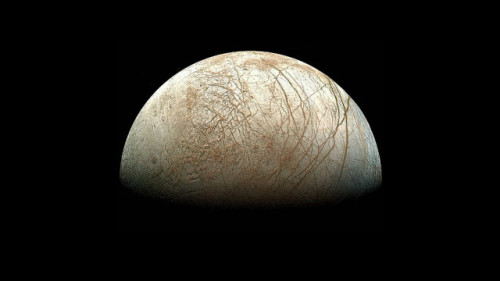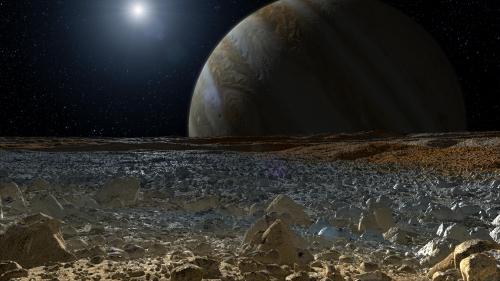Planet Rotation Periods & Axial Tilts

Planet Rotation Periods & Axial Tilts
More Posts from Tres-4b-blog and Others


NASA plans a robotic mission to search for life on Europa | io9
It looks like it’s finally going to happen, an actual mission to Jupiter’s icy moon Europa — one of the the solar system’s best candidates for hosting alien life.
Yesterday, NASA announced an injection of $17.5 billion from the federal government (down by $1.2 billion from its 2010 peak). Of this, $15 million will be allocated for “pre-formulation” work on a mission to Europa, with plans to make detailed observations from orbit and possibly sample its interior oceans with a robotic probe. Mission details are sparse, but if all goes well, it could be launched by 2025 and arriving in the early 2030s.
This is incredibly exciting. Recent evidence points to a reasonable chance of habitability. Its massive subsurface ocean contains almost twice as much water as found on Earth. The water is kept in liquid state owing to the gravitational forces exerted by Jupiter and the moon’s turbulent global ocean currents. The good news is that a probe may not have to dig very deep to conduct its search for life; the moon’s massive plumes are ejecting water directly onto the surface.
[Read more]

Hubble Space Telescope Image of Globular Cluster NGC 6397
Credit: NASA, ESA, and H. Richer (University of British Columbia)










Cosmology’s Biggest Conundrum Is A Clue, Not A Controversy
“This is not some fringe idea, where a few contrarian scientists are overemphasizing a small difference in the data. If both groups are correct — and no one can find a flaw in what either one has done — it might be the first clue we have in taking our next great leap in understanding the Universe. Nobel Laureate Adam Riess, perhaps the most prominent figure presently researching the cosmic distance ladder, was kind enough to record a podcast with me, discussing exactly what all of this might mean for the future of cosmology.
It’s possible that somewhere along the way, we have made a mistake somewhere. It’s possible that when we identify it, everything will fall into place just as it should, and there won’t be a controversy or a conundrum any longer. But it’s also possible that the mistake lies in our assumptions about the simplicity of the Universe, and that this discrepancy will pave the way to a deeper understanding of our fundamental cosmic truths.”
In science, if you want to know some property of the Universe, you need to devise a measurement or set of measurements you can make to reveal the quantitative answer. When it comes to the expanding Universe, we have many different methods of measuring light that fall into two independent classes: using the imprint of an early relic and using the cosmic distance ladder. These two techniques each give solid results that are mutually inconsistent: the distance ladder teams find results that are higher than the early relic teams by about 9%. Since the errors are only about 1-2% on each measurements, this has been dubbed cosmology’s biggest controversy.
But perhaps it’s not about “who is right,” but rather about “what is the Universe doing?” Perhaps it’s a clue, not a controversy. Come learn about the cutting-edge science behind this fascinating and unexpected result.
ayeee it was worth it the teacher said my website was the best one and i got two A’s on it!! :))
finished a 4 hour html homework now i gotta study math and programming im gonna kms i swear

“I felt I was an accepted team member. It was a great experience and a unique opportunity.”
Ruth Ann Strunk, a math major, was hired in 1968 at NASA’s Kennedy Space Center as an acceptance checkout equipment software engineer. She monitored the work of contractors who wrote the computer programs designed to check out the command module, lunar module and the Apollo J mission experiments. These experiments were conducted aboard the service modules on Apollo 15, 16 and 17 by the command module pilots.
“I am proud of the advancement and the number of women who are working and enjoy working here,” Strunk said. “It was a wonderful opportunity NASA afforded me during Apollo that I have been able to use ever since.”
Remember the women who made #Apollo50th possible.
Follow Women@NASA for more stories like this one, and make sure to follow us on Tumblr for your regular dose of space: http://nasa.tumblr.com.
-
 brebre0925 liked this · 2 months ago
brebre0925 liked this · 2 months ago -
 alanzoide reblogged this · 2 months ago
alanzoide reblogged this · 2 months ago -
 alanzoide liked this · 2 months ago
alanzoide liked this · 2 months ago -
 andron-temporis reblogged this · 3 months ago
andron-temporis reblogged this · 3 months ago -
 7-a-m liked this · 6 months ago
7-a-m liked this · 6 months ago -
 looookingup reblogged this · 11 months ago
looookingup reblogged this · 11 months ago -
 wimoketapo liked this · 1 year ago
wimoketapo liked this · 1 year ago -
 shisuidagoatt reblogged this · 1 year ago
shisuidagoatt reblogged this · 1 year ago -
 atebu reblogged this · 3 years ago
atebu reblogged this · 3 years ago -
 shapeshifteuse liked this · 3 years ago
shapeshifteuse liked this · 3 years ago -
 princessnefertankh liked this · 3 years ago
princessnefertankh liked this · 3 years ago -
 astrabee reblogged this · 3 years ago
astrabee reblogged this · 3 years ago -
 unrealcosima liked this · 3 years ago
unrealcosima liked this · 3 years ago






